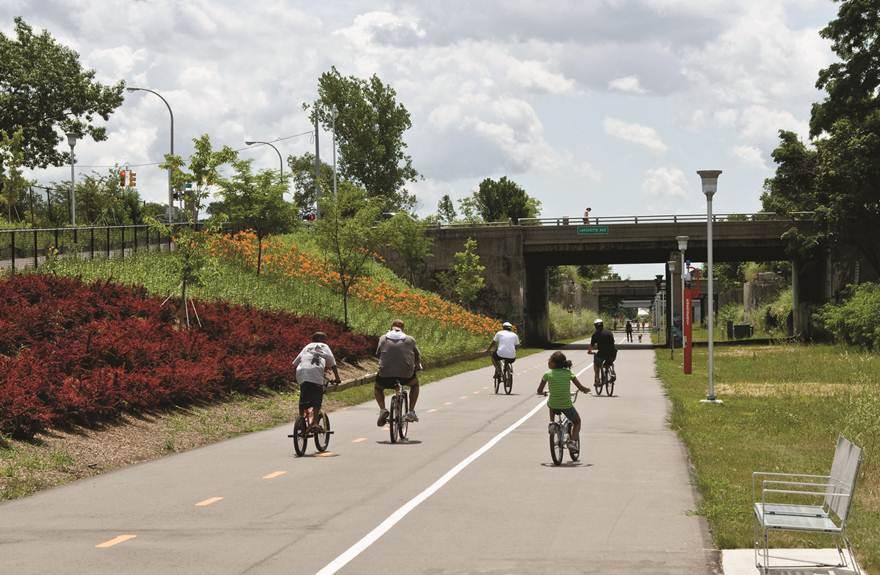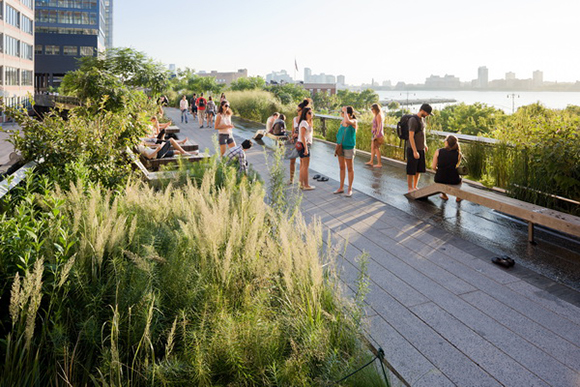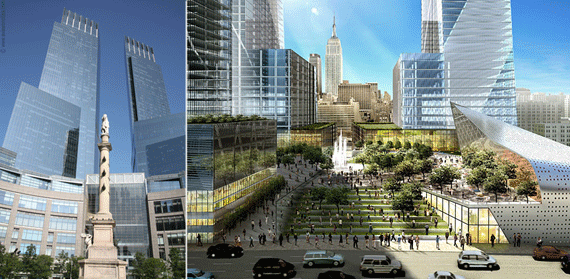The U.S. is full of jaw-dropping parks, from expansive National Parks like the Grand Canyon to carefully cultivated botanical gardens like Portland, Oregon’s Japanese Garden. But one of the most unique green spaces in cities is the linear park.
Longer than they are wide, linear parks take people on a journey through the city. They can be as short as a few blocks—even the expanse of a single bridge—or as long as several miles, but linear parks differ from traditional green spaces thanks to their proportions. They often serve as a link in a city’s plans to boost alternative transportation, a thoroughfare carrying pedestrians, rollerbladers, bikers and more.
In traveling from one block or neighborhood to the next, people see the city through a different lens when they use a linear park. This is especially true because many linear parks are repurposed from elevated historic rail lines or highways, transforming infrastructure into a space for recreation.
Although the difference between a linear park and a trail or bike path can get a bit confusing, linear parks aren’t only used for transportation. The parks have overlooks, playgrounds, art installations, and places to picnic; these are spaces that encourage both movement and relaxation.
From Storm Cunningham‘s Resilience Strategy Guide:
Manhattan’s High Line Park. Atlanta’s Beltline. Chicago’s Bloomingdale Trail. Philadelphia’s Reading Viaduct. Seoul’s Cheonggyecheon. Detroit’s Dequindre Cut Greenway. Paris’ Promenade Plantée. Toronto’s The Bentway. Jersey City’s The Embankment. Rotterdam’s Hofplein. Singapore’s Green Corridor.
What do the revitalizing, leading-edge projects listed above have in common? All are based on:
- Repurposing (adapting) old infrastructure and unused spaces;
- Renewing and greening those spaces for pedestrian and/or bicycle usage; and
- Reconnecting isolated and/or distressed neighborhoods.
The same “3Re” approach is also being used to revitalize our natural environment, such as repurposing abandoned farms or golf courses as public parks; renewing their biodiversity & structure; and reconnecting isolated, dying ecosystems (such as via dam removal) to allow migratory activities and nutrient flows.
If forced to use just 3 words, I posit that “Repurpose. Renew. Reconnect.” could serve as a “universal” core for revitalization strategies (or resilience strategies, since both are emergent qualities deriving from similar factors). Why? Because worldwide, our cities are plagued by obsolete, damaged / depleted, and fragmented assets.
Repurposing is usually the first step: finding an appropriate new use for an old asset or property attracts funding and public support. That funding and support then enables renewal (restoration, redevelopment, etc.). Finally, reconnecting that asset provides access, which unleashes social and economic vibrance. Repurposing and renewing are mostly done at the local level, but the most important reconnecting can often only be done at the county, regional, or even national levels.
What happens when repurposing, renewing, and reconnecting meet? Magic.
Just look at the High Line Park. New York City planned to spend millions of dollars demolishing this defunct elevated railway. Keeping the ugly relic made no sense, until two local citizens–Robert Hammond and Josh David–envisioned repurposing it as a linear park.
That unleashed funding for renewing the structure as a beautiful green pedestrian space, which more than doubled nearby real estate values. In its first decade, the High Line generated $2.2 billion in new economic activity. The city expects over $1 billion in increased tax revenues over the next 20 years. It’s visited by over 5 million people annually, making it the city’s 2nd most visited cultural attraction.
But that’s not all. By reconnectingneighborhoods on the lower west side of Manhattan with the Hudson Rail Yards, the High Line enabled the city to do something they had envisioned for decades: cap and develop the space above the rail yards.
This is now happening: the $20 billion Hudson Yards mixed-use redevelopment is the largest real estate transaction in New York City history. That’s a 3Re-based strategy at work.
Here’s the key lesson from the High Line: Repurposing, renewing, and reconnecting are each powerful and effective on their own. Many communities have been revitalized using just one of these tactics. But the magic occurs when all three are combined to reinforce each other, thus forming a true revitalization strategy. NOTE: While repurposing often precedes renewing, it’s not unusual for reconnecting to come first. Restoring vital flows to a place that’s been isolated can trigger renewal, with no need to repurpose it. Those flows could be water, nutrients, pedestrians, shoppers, traffic, migrating wildlife, etc. For instance, reconnecting a neighborhood by removing an urban highway often triggers redevelopment (renewal).
Photo of Detroit’s Dequindre Cut Greenway courtesy of the Detroit Riverfront Conservancy.




America’s smaller cities are embracing the knowledge economy and leading innovation – The European Sting - Critical News & Insights on European Politics, Economy, Foreign Affairs, Business & Technology - europeansting.com - DLIT
[…] previously abandoned. In Atlanta’s Beltline, the stranded assets of rail lines are turned into parks. Cleveland’s Whiskey Island, once a busy industrial area, is converted to an idyllic lakefront. […]